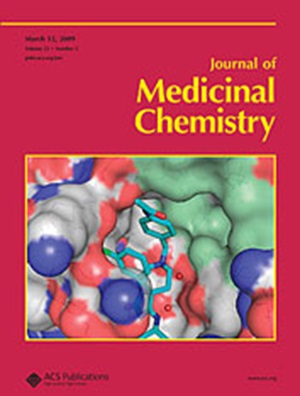Discovery of Pyrazolo[1,5,4-de]quinoxalin-2(3H)-one Derivatives as Highly Potent and Selective PARP1 Inhibitors
IF 6.8
1区 医学
Q1 CHEMISTRY, MEDICINAL
引用次数: 0
Abstract
Poly-ADP-ribose-polymerase 1/2 (PARP1/2) inhibitors have been approved for cancers with homologous recombination deficiency (HRD). However, their narrow therapeutic indexes largely due to hematologic toxicities have limited their clinical usefulness. Developing selective PARP1 inhibitors has emerged as an attractive strategy to achieve equivalent antitumor activity while alleviating the hematological toxicity caused by PARP2 inhibition. Herein, we report the discovery of pyrazolo[1,5,4-de]quinoxalin-2(3H)-one 30 as a novel selective PARP1 inhibitor. 30 formed tighter PARP1-DNA trapping than AZD9574, leading to better potency in inhibiting cancer cell proliferation. 30 achieved tumor regression in the BRCA1-mutated MDA-MB-436 xenograft model and showed synergistic efficacy in combination with carboplatin in the SUM149PT xenograft model. In the rat hematological toxicity study, 30 exhibited minimal impact on hematological parameters at 25 mg/kg, while AZD5305 at 1 mg/kg caused 56.5% reduction of reticulocyte. Taken together, we discovered compound 30 with a therapeutic index superior to that of PARP1 inhibitors AZD5305 and AZD9574 in the preclinical setting.

发现吡唑并[1,5,4-de]喹喔啉-2(3H)-酮衍生物作为高效力和选择性 PARP1 抑制剂
聚ADP核糖聚合酶1/2(PARP1/2)抑制剂已被批准用于治疗同源重组缺陷(HRD)癌症。然而,这些抑制剂的治疗指数较窄,主要是由于血液学毒性,限制了它们的临床应用。开发选择性 PARP1 抑制剂已成为一种极具吸引力的策略,既能获得同等的抗肿瘤活性,又能减轻 PARP2 抑制引起的血液学毒性。在此,我们报告了吡唑并[1,5,4-de]喹喔啉-2(3H)-酮 30 作为新型选择性 PARP1 抑制剂的发现。与 AZD9574 相比,30 能形成更紧密的 PARP1-DNA 捕获,从而在抑制癌细胞增殖方面具有更好的效力。30 在 BRCA1 突变的 MDA-MB-436 异种移植模型中实现了肿瘤消退,在 SUM149PT 异种移植模型中与卡铂联用显示出协同疗效。在大鼠血液学毒性研究中,25 毫克/千克的 30 对血液学参数的影响极小,而 1 毫克/千克的 AZD5305 会导致网织红细胞减少 56.5%。综上所述,我们发现化合物 30 在临床前的治疗指数优于 PARP1 抑制剂 AZD5305 和 AZD9574。
本文章由计算机程序翻译,如有差异,请以英文原文为准。
求助全文
约1分钟内获得全文
求助全文
来源期刊

Journal of Medicinal Chemistry
医学-医药化学
CiteScore
4.00
自引率
11.00%
发文量
804
审稿时长
1.9 months
期刊介绍:
The Journal of Medicinal Chemistry is a prestigious biweekly peer-reviewed publication that focuses on the multifaceted field of medicinal chemistry. Since its inception in 1959 as the Journal of Medicinal and Pharmaceutical Chemistry, it has evolved to become a cornerstone in the dissemination of research findings related to the design, synthesis, and development of therapeutic agents.
The Journal of Medicinal Chemistry is recognized for its significant impact in the scientific community, as evidenced by its 2022 impact factor of 7.3. This metric reflects the journal's influence and the importance of its content in shaping the future of drug discovery and development. The journal serves as a vital resource for chemists, pharmacologists, and other researchers interested in the molecular mechanisms of drug action and the optimization of therapeutic compounds.
 求助内容:
求助内容: 应助结果提醒方式:
应助结果提醒方式:


